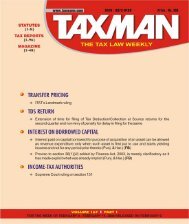news round up - Taxmann
news round up - Taxmann
news round up - Taxmann
- TAGS
- news
- round
- taxmann
- taxmann.com
Create successful ePaper yourself
Turn your PDF publications into a flip-book with our unique Google optimized e-Paper software.
2010] GST-2010 - THE SINGLE RATE GST STRUCTURE - IS IT VIABLE ? 127<br />
luxuries are taxed at higher rate. The rate of tax is 4 per cent and 12.5 per<br />
cent in general and - the food grains, oil seeds, iron and steel, coal, cotton,<br />
etc., are taxed at 4 per cent. Further, the list of 4 per cent taxability included<br />
the minerals and most of the industrial inputs including machinery and<br />
their spares and this system is working very well. The goods which are not<br />
included in the list of 4 per cent (and further not in special list of exemption<br />
or 1 per cent taxability) are taxed at 12.5 per cent. The general rate of 12.5<br />
per cent was recommended by the white paper issued by the Empowered<br />
Committee of States’ Finance Ministers on VAT but later some of the<br />
States violated it by making it 14 per cent.<br />
While advocating the single rate system, some of the facts considered are<br />
administrative convenience and the better collection of tax in comparison<br />
to multiple tax rate system but some of the facts have not been taken into<br />
account while discussing and recommending the single rate system and<br />
these are very vital and will go to the root of basic viability of the single rate<br />
system in the ‘dual GST’ format. Some of the goods are not subject to any<br />
Central indirect taxation due to the fact that Central excise is not payable<br />
on these goods but since we are going for dual taxation system ‘CGST’ will<br />
be applicable on them also unless specific exemption is provided and more<br />
the exemptions will be provided more it will distort the basic system of<br />
taxation.<br />
Take the example of food grains which are at present taxable at the rate<br />
of 4 per cent. When these goods are sent from one State to another State,<br />
the effective rate is only 2 per cent CST and VAT paid within the State is<br />
eligible for set off if the goods are sole inter-State. No Central excise duty<br />
is payable on food grains and if the exemption is given to these goods on<br />
this account, even then the rate of tax under SGST (as suggested single<br />
rate) will be 7 per cent and if no exemption is given under CGST, then the<br />
rate will 12 per cent (7 per cent SGST and 5 per cent CGST) and this will<br />
increase the rate of tax to manifold as compared to the existing rate. Note<br />
that the States still do not agree to this rate of 12 per cent and advocating<br />
for the rate of 15 per cent. This is applicable to all the goods which are<br />
subject to lower rate and further not covered by the Central excise.<br />
Introducing the new taxation system in a big country like India is not a<br />
theoretical exercise and tax system cannot be modified to that extent only<br />
for the sake of administrative convenience and increase in the revenue<br />
without knowing and discussing the basics of the requirement of tax<br />
paying public including the trade and industry.<br />
The multiple rate system will certainly distort the administrative set <strong>up</strong> of<br />
the GST but the lawmakers are not giving us the ‘standard National GST’<br />
and dual GST is only a compromise even without asking the trade and<br />
industry which was waiting for the Single national GST as promised to<br />
them in 2006 by our lawmakers. If there is a compromise on the basics of<br />
GST, then we will receive the more complicated and complex indirect tax<br />
GOODS & SERVICES TAX CASES ❑ JANUARY 20 - FEBRUARY 4, 2010 ◆ 37











![“FORM NO. 3CEB [See rule 10E] Report from an ... - Taxmann](https://img.yumpu.com/45480232/1/190x245/form-no-3ceb-see-rule-10e-report-from-an-taxmann.jpg?quality=85)





